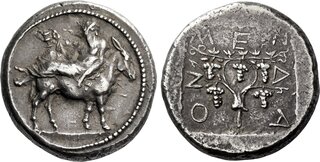| Numismatica Ars Classica > Auction 146 | Auction date: 8 May 2024 |
| Lot number: 2141 Price realized: This lot is for sale in an upcoming auction - Bid on this lot  | Show similar lots on CoinArchives Find similar lots in upcoming auctions on |
| Lot description: Mende. Tetradrachm circa 460-425, AR 26 mm, 17.23 g. Elderly Dionysus, wearing ivy wreath and himation, reclining on mule's back l., holding cantharus with r. hand and resting l. on the animal's side. Rev. ΜΕΝ – ΔΑ – ΙΟ – Ν around linear square containing vine with four bunches of grapes; all within incuse square. AMNG pl. I, 16 (this coin). MGK 455 (this coin). SNG ANS 347. Gulbenkian 412. Noe, Mende 81 (this coin). Rare. A lovely specimen of this desirable issue of excellent style with a superb old cabinet tone. Minor area of weakness on reverse, otherwise extremely fine Ex Hess-Leu 3, 1956, 266 and NGSA 7, 2012, 53 and Paul-Francis Jacquier 49, 2021, 82 sales. From the Kaliandra hoard (IGCH 358) and from the R. Käppeli collection. Mende excelled in the wine trade, rivalling Thasos, Maronea, Naxos, Lesbos and Chios. The ancient authorities Cratippus, Athenaeus, Menander, Hermippus of Smyrna and Demosthenes all speak of the quality and fame of Mende wine. Thus, it is not surprising that on its principal trade coin, the tetradrachm, Mende would choose a design that celebrated wine production. Indeed, most coins of the city bear designs that refer to wine production or to the retinue of Dionysus, the god of wine. On this example we see an elderly Dionysus in luxurious repose on the back of an ass, clutching a cantharus of wine. As shown here, he usually relaxes with his left arm downward, but on occasion (Mende [Kaliandra] Hoard no. 65) he assumes an even more decadent pose with his left arm propped upon the head of the ass; on other examples the god's identification is further secured by the fact that he holds a thyrsus (Mende (Kaliandra) Hoard nos. 60, 61, 63). Hardly a more appropriate image exists of this god, famed for his wild indulgences and his appreciation for the fruit of the vine. Of great interest is the contrast between the god and the ass: the stiff, servile attitude of the mount contrasts sharply with the decadent, reclining figure of Dionysus. While the ass is focused and dedicated to his workaday task, with its musculature taut and well defined, Dionysus appears unconcerned and soft in his physical form. In that sense we have two completely different works of art compressed into one scene. The contrast can hardly be accidental, and it must have provided the die engraver with the challenge of unifying these disparate elements into seamless coexistence. Estimate: 25000 CHF |  |



